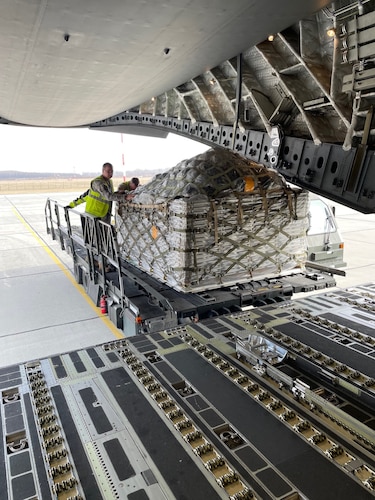Imagine the chaos in this scenario: during an Air Force airlift mission to deliver mission-critical supplies, a cargo pallet slams into a rail system on an aircraft causing costly damage and impacting the mission.
This very real problem has previously caused issues for airlift aircraft crews, maintainers and mission planners alike.
In 2019, then Tech. Sgt. Brett Kiser was assigned to Al Udeid Air Base, Qatar, working on loading operations for airlift of critical munitions. He observed a loading incident on a C-17 Globemaster III in which a pallet struck the aircraft's logistic rail system, causing significant damage and cascading impacts to the mission. Seeking a solution, Kiser and his team started working to develop an installable device to help prevent undesired pallet movement. They began testing and evaluating its use over numerous missions, demonstrated its effectiveness. They branded it the "K-Wedge" after the 379th Air Expeditionary Wing's historic tail flash, commemorating the partnership between Air Mobility Command and the U.S. Air Forces Central Airmen who developed the prototype.
"Our team knew the prototype would succeed for a few reasons; the first was the prototype's structural integrity could withstand the brute force of ammo pallets during loading operations," Kiser said. "The second was the overwhelming feedback from end-users. Near the end of the two-month test phase, the aircrew would make 30-minute outcalls requesting 'K-Wedge support.' The local flight line community quickly embraced it as a preferred, preventative measure to keep the planes flying unhindered by rail damage and reduced payloads. It was a tool that not only worked, but it was made by Airmen for Airmen."
In 2020, Kiser and his team competed in Air Force Spark Tank 2020, a service-wide competition to demonstrate innovative ideas. They tied for second place and got their invention backed for further development by the highest levels of Air Force leadership. The K-Wedge was then sent through an extensive period of research and development.
Recently, the Boeing NATO program manager requested to implement the K-Wedge for testing in critical airlift missions with the Heavy Airlift Wing, a multinational airlift wing providing strategic airlift capabilities to 12 NATO and partner nations.
"The Heavy Airlift Wing prototype test was unexpected until Boeing's NATO program manager proposed a plan to protect the HAW's C-17 logistics rails from damage while transporting arms and ammunition to support Ukraine," Kiser said. "The CSAF Strategic Studies Group, Tesseract [Headquarters Air Force/A4LR], AMC A4T, and the Boeing NATO manager traveled to Papa, Hungary, and successfully tested the prototype for three days on C-17 aircraft. During this trial, the testing team gathered end-user feedback from NATO aircrew and load team members."
AMC A4T oversaw prototype testing, provided historical C-17 rail damage data, and documented lessons learned for future stateside tests. Meanwhile, Tesseract leveraged available funding and liaised with industry to modernize the prototype for this test. The HAW approved the test, hosted all parties, and facilitated the test on their C-17 aircraft using available personnel and equipment. Additionally, Boeing coordinated the test with the HAW and provided engineering support. Finally, Bunker Supply developed the modernized prototype and measured/documented the loading tests with high-tech tools.
"AMC A4T, Tesseract, and our team are extremely grateful and excited for the project's recent progress due to the teamwork and shared vision of accelerating combat innovation efforts with allies and partners," Kiser said. "Our excitement is further elevated by the positive feedback we receive from Airmen in the loadmaster, maintenance and aerial port communities who have witnessed the prototype demonstrations. We want to make their roles easier and provide added confidence by eliminating unnecessary aircraft damage."
Kiser explained that this industry and international partnerships have helped pave a potential path for future multinational innovative solutions.
"The amazing relationships with AMC A4T and Tesseract made the HAW test possible through years of design, iteration and partnership. Both organizations continue to lead the way in supporting Airman innovation projects by advocating and working on various projects due to a shared vision of improving the department's rapid global mobility capabilities during this time of consequence."
Kiser has now attained the rank of senior master sergeant and is currently the senior enlisted leader for the chief of staff of the Air Force Strategic Studies Group.









